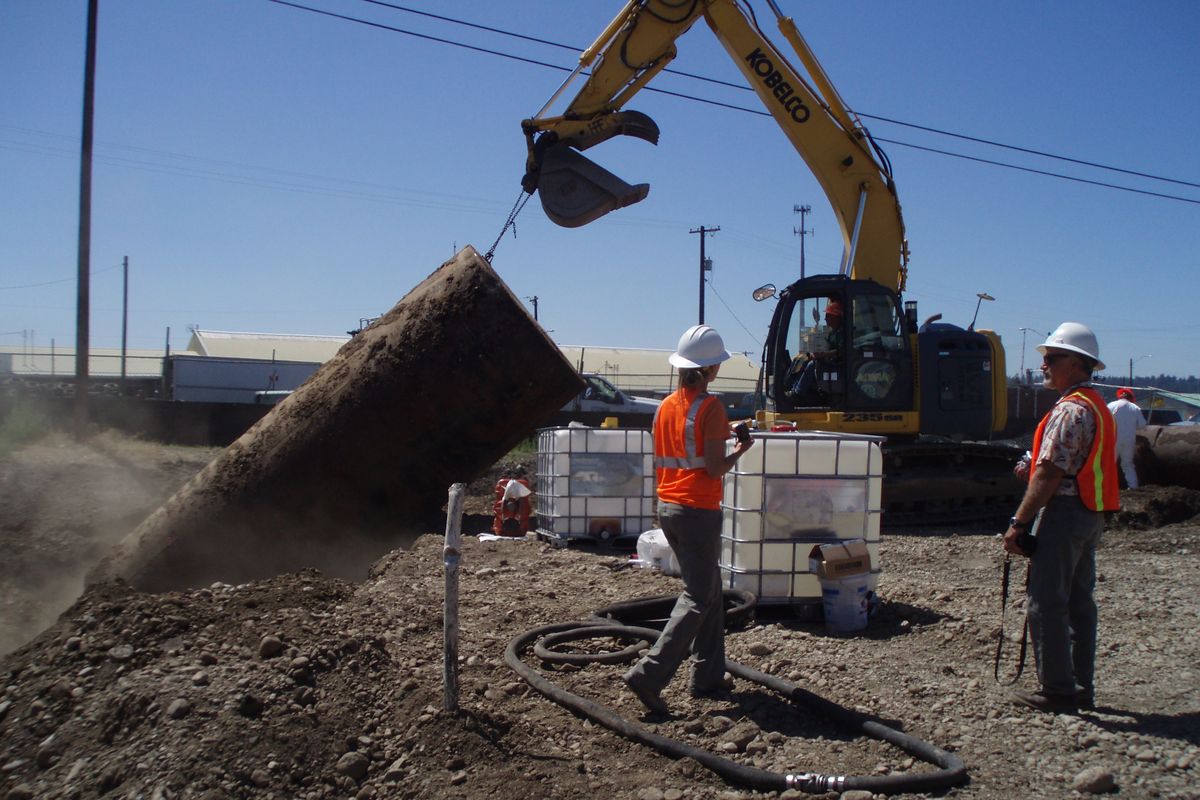City Parcel cleanup a poster child for Ecology’s attack on PCBs

When heavy equipment rolled into a toxics cleanup site in east Spokane last June to obliterate a big building that used to house City Parcel, workers found more than they bargained for.
Knocking over the 18,400 square foot building exposed three underground storage tanks holding PCB (polychlorinated biphenyls)-laden oils, four dry wells with PCB sediments and heavily contaminated floor drains and drain lines.
Before the local packaging and delivery company occupied the site it belonged to Spokane Transformer, Inc. an electrical transformer repair and recycling business. So you can guess what that means—PCBs.
Another day in the life of the Washington Department of Ecology’s Toxics Cleanup Program? Not really.
This was a landmark cleanup job, involving a site heavily contaminated by a nasty toxic chemical, further complicated by a long list of potentially liable parties who had very little money, and a history that began in the 1970s.
All in all, 33 years passed from when the U.S. Environmental Protection Agency began its investigation in 1976 and the day the building came down. In 1997 Ecology took the lead.
Before tearing down the building, contractors removed asbestos materials from inside the building and cleaned up outside.
Contractors began their work by removing asbestos from the building and cleaning up the soil surrounding the facility. After the building was demolished, more soil was excavated and the underground storage tanks, floor drains and drain lines were removed. Trucks hauled more than 8,200 tons of PCB-contaminated material to facilities where they would be properly treated or disposed.
Cleanup at the former City Parcel site is a big deal in Spokane where toxics in the Spokane River are looming in the near future as the issue du jour and PCBs are viewed as especially heinous.
Ecology’s Eastern Regional Office has recently developed a multi-program strategy for tackling toxics such as PCBs in the water and sediments of the Spokane River.
While you can read the strategy online, “nowhere in the strategy can we expect to get such massive, measureable, instant, and direct improvements as after a cleanup like the one at City Parcel,” said TCP supervisor Mike Hibbler.
You can see that strategy here: http://www.ecy.wa.gov/geographic/spokane/images/clean_up_strategy_toxics_in_srws_82009.pdf .
PCBs are a mixture of man-made chemicals historically used as insulating fluids, coolants and lubricants in transformers, capacitors or other electrical equipment. PCB production was halted in the United States in 1977 because they can be harmful to human health and persist in the environment.
Exposure to PCBs can cause a number of health problems from skin rashes to liver and thyroid damage and birth defects. Other effects of PCBs that scientists have observed in animals include changes in the immune system, behavioral alterations, and impaired reproduction.
The PCBs at the City Parcel site are suspected to have made their way to the Spokane River via groundwater. Although PCBs were not found in recent groundwater monitoring, a small amount was detected years ago in one well. Ecology urban waters inspectors Arianne Fernandez and Ted Hamlin received “hits” of PCBs in the storm drain sediments nearby.
Leading up to the clean-up were years of foiled attempts at negotiation with the former owners of the facility: Richard Boyce, Jerry Overton, and Paul Gisselberg. Boyce owned the site when it was a transformer repair and recycling operation until 1974. Overton leased the property from Boyce and operated Spokane Transformer until the property was sold to City Parcel’s owner, Paul Gisselberg, in 1980.
Because the parties were unable to reach agreement on studying and cleaning up the site, Ecology conducted a study to characterize the contamination, using state funds. Ecology then prepared a cleanup action plan in 2004.
“Just because this site was difficult, in terms of the sheer amount of toxic material and in terms of the liable parties involved, didn’t mean we shouldn’t try with all we had to clean it up,” said Jim Pendowski, Ecology’s TCP program manager.
Ecology took legal action against Boyce, Overton and Gisselberg when they didn’t comply with requirements to clean up the site. Finally, in late December 2007, TCP and the former owners reached three separate settlements to clean up the site.
The settlement agreements, called Consent Decrees, required each of the responsible parties to contribute money toward the cleanup. The total settlement amount from Boyce, Overton and Gisselberg was about $270,000. The total of the site cleanup was $1.6 million. The state’s taxpayers shouldered the remainder of the bill.
Ecolink is provided by the Communications staff of the Eastern Region of Washington Department of Ecology. For more information, visit www.ecy.wa.gov.